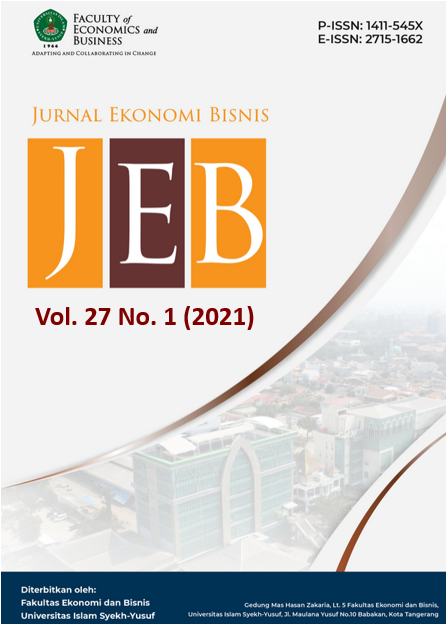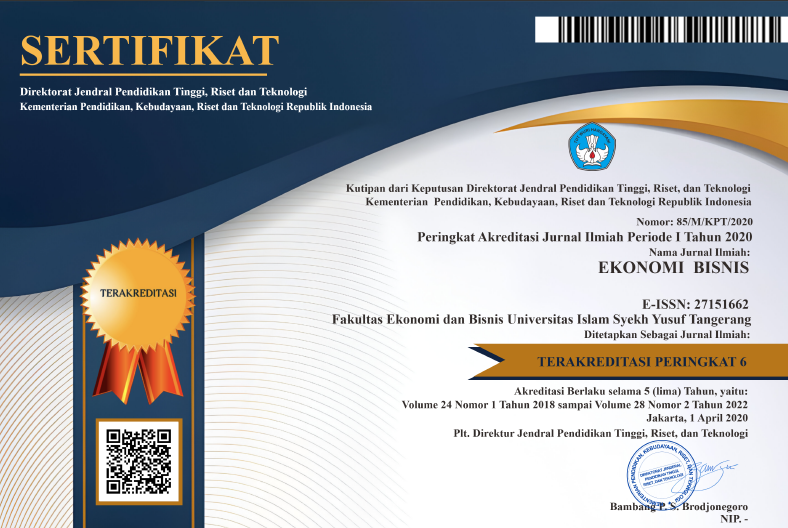ANALYSIS OF DIFFERENCES OF PRICE EARNING RATIO (PER) AND STOCK LIQUIDITY BEFORE (10 DAYS) AND AFTER (10 DAYS) STOCK SPLIT IN GO PUBLIC COMPANY IN INDONESIA STOCK EXCHANGE PERIOD 2009 – 2016
DOI:
https://doi.org/10.33592/jeb.v27i1.1344Abstract
The purpose of this research is to know (1) difference of stock liquidity level before and after stock split (2) difference of Price Earning Ratio (PER) before and after stock split.The population used in this study are all companies listed on the Indonesia Stock Exchange. While the sample selection is taken by using purposive sampling method. The number of samples used by researchers are 62 companies listed on the Indonesia Stock Exchange and stock split in the period 2009-2016.Based on the results of research indicate that there is a significant difference in Price Earning Ratio (PER), either before stock split or Price Earning Ratio (PER) after stock split. With paired sample t-test results obtained t test with t count> t table (3.912> 2,000) can be concluded then Ho accepted means there is a difference between price earnings ratio (PER) of each sample company, either before stock split or price Earnings ratio (PER) after the stock split event.With paired sample t-test obtained t test results with t count> t table (1,844> 2,000) can be concluded then Ho accepted means there is no difference between the stock liquidity of each sample company, either before the stock split and the liquidity of stock after the event Stock split.
References
Arisona, V. F. 2013. Faktor-faktor yang mempengaruhi price earning ratio pada indeks lq 45 di bursa efek indonesia. Jurnal Ilmu Manajemen 1 (1).
Ewijaya dan Nur Indriantoro (1999), Analisis Pengaruh Pemecahan Saham terhadap Perubahan Harga Saham. Jurnal Riset Akuntasi Indonesia.
Gitman, Lawrence J, 2006, Principles of Managerial Finance (11th ed.), Boston: Addison Wesley
Hadi, Nur, 2013. Pasar Modal. Yogyakarta : Graha Ilmu
Indonesia, Undangundang Pasar Modal. Undang-Undang N0o.8 Tahun 1995. LN. No. 64 Tahun 1995, TLN No. 3608.
Investment Analysis and Management (Fifth Edition). New York : John Jones, Charles P (1996). Wiley and Sons Inc.
Keown, Arthur J, John D. Martin, William J. Petty & David F. Scott Jr. 2005. Financial Management, Principal and Applications. Prentice Hall.
Margaretha, Farah dan Irma Damayanti. 2008. Pengaruh Price Eraninmg Ratio, Dividend Yield dan Market To Book Ratio Terhadap Stock Return di Bursa Efek Indonesia. Jurnal Bisnis dan Akuntansi, 10(3), h: 149-160.
Miliasih, Retno. (2000). Analisis Pengaruh Stock Split Terhadap Earning Per Share, Jurnal Bisnis dan Akuntansi. Universitas Gajah Mada.Vol.2,no.2, 131-144.
Ross, A.S., R.W. Westeaterfield and J. Juffe (1999), Corporate Finance (fifth Edition). Boston : Irwan.Mc-Graw-Hill
Santoto. Singgih (2000), Buku latihan SPSS Statistik Parametik, Jakarta : PT. Alex Media Komputindo.
Sartono, Agus. 2006. Manajemen Keuangan Teori dan Aplikasi. Edisi Ketiga. Yogyakarta: BPFE-Yogyakarta.
Downloads
Published
How to Cite
Issue
Section
License
Copyright (c) 2021 EKONOMI BISNIS

This work is licensed under a Creative Commons Attribution-NonCommercial-ShareAlike 4.0 International License.



